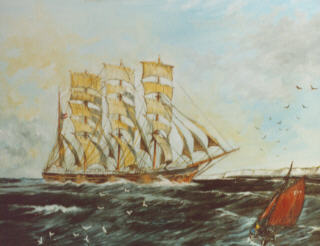The Sinking of the Garthpool
In Stan's own words........(sound
file)
The Last Voyage of the Garthpool as related in
Sea Breezes Magazine 1930
Jutepolis
A four-masted steel barque built in 1891 by W.B. Thompson & Co. Dundee,
as yard no. 107. Dimensions 94,48×13,71×7,64 m [310'0"×45'0"×25'1"] and
tonnage 2842 GRT and 2652 NRT. Rigged with with nothing over double
topgallant sails.
- 1891 December 3
- Launched at the shipyard of W.B. Thompson & Co., Dundee, for C.
Barrie, Dundee. Assigned the British Official No. 99207.
- 1899
- Sold to Jutepolis Sailing Ship Co. Ltd (F.E. Bliss manager), London,
together with
Lawhill for £ 39.000.
- 1900
- Transferred to
Anglo-American Oil Co., London.
- 1911
- Sold to George Windram & Son, Liverpool, for £ 6500.
- 1917
- Sold to Marine Navigation Co. of Canada Ltd. (Sir William Garthwaite
manager), London.
- 1920
- Renamed Garthpool.
- 1922
- Registered in Montreal but still flying the British flag.
- 1927 October 13 — January 13
- Sailed from Dublin to Adelaide in 92 days.
- 1929 November 11
- Wrecked at Boavista, Cape Verde Islands, on voyage from Hull to
Adelaide in ballast.

(formerly Juteopolis) Bark (4m). L/B/D:
310 × 45 × 25 (94.5m × 13.7m × 7.6m). Tons: 2,652 net. Hull:
steel. Comp.: 28. Built: Messrs. Thompson & Co., Dundee,
Scotland; 1891.
A four-masted bark sporting a jubilee rig—that is, setting no sails
above the topgallants—Juteopolis was built for the jute trade
between Calcutta and Dundee, in which she sailed under Captain W.
Linklater for nearly a decade. In 1900 she was bought by the
Anglo-American Oil Company and carried case oil in the Pacific. Sold just
before World War I to George Windram and Company, Liverpool, she hauled
general cargoes. In 1917, she was acquired by Sir William Garthwaite's
Marine Navigation Company, though she was not formally renamed until 1921.
On her first voyage as Garthpool, Captain Atkinson died at sea en
route from Port Lincoln to Falmouth in 1921. With freight rates low, the
ship was laid up for two years at the end of that passage. In 1924, her
port of registry was changed to Montreal and she sailed again in general
trade. Two years later, she changed masters again, sailing under Captain
David Thomson in the Australia grain trade between Adelaide and, usually,
Hull; she was not a fast ship, and her passages often exceeded 120 days.
On October 23, 1929, she was outward bound from Hull in ballast. Among the
crew was Stan Hugill, who would later earn international renown as a
chanteyman and historian of the last days of sail. On November 11, 1929,
Garthpool ran aground and was lost at Boavista Island, one of the
Cape Verde Islands; all hands survived. She is
often credited with having been the last British deep-water sailing
ship—flying as she did the Canadian merchant ensign.
|